A New Approach to the Fabrication of Memristive Neuromorphic Devices: Compositionally Graded Films
Abstract
1. Introduction
2. Materials and Methods
2.1. Compositionally Graded g-Al:MgZnO Films
2.2. AACVD of g-Al:MgZnO Films
2.3. Analysis of g-Al:MgZnO Films and Electrical Measurements
3. Results and Discussion
3.1. Analysis of Composition and Structure of g-Al:MgZnO Films
3.2. I-V and C-V Characteristics of g-Al:MgZnO Films
3.3. Effects of Bipolar Voltage Pulse Trianing
3.4. Reliability Tests for Memristor
4. Summary and Conclusions
Funding
Acknowledgments
Conflicts of Interest
Appendix A
References
- Backus, J. Can programming be liberated from the von Neumann style? A functional style and its algebra of programs. Commun. ACM 1978, 21, 613–641. [Google Scholar] [CrossRef]
- Mead, C. Neuromorphic electronic systems. In Proceedings of the IEEE; Institute of Electrical and Electronics Engineers (IEEE): Piscataway, NJ, USA, 1990; Volume 78, pp. 1629–1636. [Google Scholar]
- Kandel, E.R.; Schwartz, J.H.; Jessell, T.M.; Steven, A.S.; Hudspeth, A.J.; Mack, S. Principles of Neural Science; McGraw Hill: New York, NY, USA, 2015. [Google Scholar]
- Jo, S.H.; Chang, T.; Ebong, I.; Bhadviya, B.B.; Mazumder, P.; Lu, W.D. Nanoscale Memristor Device as Synapse in Neuromorphic Systems. Nano Lett. 2010, 10, 1297–1301. [Google Scholar] [CrossRef] [PubMed]
- Kuzum, D.; Yu, S.; Wong, H.-S.P. Synaptic electronics: Materials, devices and applications. Nanotechnology 2013, 24, 382001. [Google Scholar] [CrossRef] [PubMed]
- Merolla, P.A.; Arthur, J.V.; Alvarez-Icaza, R.; Cassidy, A.S.; Sawada, J.; Akopyan, F.; Jackson, B.L.; Imam, N.; Guo, C.; Nakamura, Y.; et al. A million spiking-neuron integrated circuit with a scalable communication network and interface. Science 2014, 345, 668–673. [Google Scholar] [CrossRef] [PubMed]
- Gkoupidenis, P.; Koutsouras, D.A.; Malliaras, G.G. Neuromorphic device architectures with global connectivity through electrolyte gating. Nat. Commun. 2017, 8, 15448. [Google Scholar] [CrossRef] [PubMed]
- Wang, Z.; Joshi, S.; Savel’Ev, S.E.; Jiang, H.; Midya, R.; Lin, P.; Hu, M.; Ge, N.; Strachan, J.P.; Li, Z.; et al. Memristors with diffusive dynamics as synaptic emulators for neuromorphic computing. Nat. Mater. 2016, 16, 101–108. [Google Scholar] [CrossRef]
- Zhao, M.; Gao, B.; Tang, J.; Qian, H.; Wu, H. Reliability of analog resistive switching memory for neuromorphic computing. Appl. Phys. Rev. 2020, 7, 011301. [Google Scholar] [CrossRef]
- Yang, J.J.; Pickett, M.D.; Li, X.; Ohlberg, D.A.A.; Stewart, D.R.; Williams, R.S. Memristive switching mechanism for metal/oxide/metal nanodevices. Nat. Nanotechnol. 2008, 3, 429–433. [Google Scholar] [CrossRef]
- Tuma, T.; Pantazi, A.; Le Gallo, M.; Sebastian, A.; Eleftheriou, E. Stochastic phase-change neurons. Nat. Nanotechnol. 2016, 11, 693–699. [Google Scholar] [CrossRef]
- Locatelli, N.; Cros, V.; Grollier, J. Spin-torque building blocks. Nat. Mater. 2013, 13, 11–20. [Google Scholar] [CrossRef]
- Chanthbouala, A.; García, V.; Cherifi, R.O.; Bouzehouane, K.; Fusil, S.; Moya, X.; Xavier, S.; Yamada, H.; Deranlot, C.; Mathur, N.D.; et al. A ferroelectric memristor. Nat. Mater. 2012, 11, 860–864. [Google Scholar] [CrossRef] [PubMed]
- Wong, H.-S.P.; Salahuddin, S. Memory leads the way to better computing. Nat. Nanotechnol. 2015, 10, 191–194. [Google Scholar] [CrossRef] [PubMed]
- Indiveri, G.; Liu, S.-C. Memory and Information Processing in Neuromorphic Systems. Proc. IEEE 2015, 103, 1379–1397. [Google Scholar] [CrossRef]
- Ohno, T.; Hasegawa, T.; Tsuruoka, T.; Terabe, K.; Gimzewski, J.K.; Aono, M. Short-term plasticity and long-term potentiation mimicked in single inorganic synapses. Nat. Mater. 2011, 10, 591–595. [Google Scholar] [CrossRef] [PubMed]
- Zhou, Z.; Yan, X.; Zhao, J.; Lu, C.; Ren, D.; Lu, N.; Wang, J.; Zhang, L.; Li, X.; Wang, H.; et al. Synapse behavior characterization and physical mechanism of a TiN/SiOx/p-Si tunneling memristor device. J. Mater. Chem. C 2019, 7, 1561–1567. [Google Scholar] [CrossRef]
- Covi, E.; Lin, Y.-H.; Wang, W.; Stecconi, T.; Milo, V.; Bricalli, A.; Ambrosi, E.; Pedretti, G.; Tseng, T.-Y.; Ielmini, D. A Volatile RRAM Synapse for Neuromorphic Computing. In Proceedings of the 2019 26th IEEE International Conference on Electronics, Circuits and Systems (ICECS), Genoa, Italy, 27–29 November 2019; Institute of Electrical and Electronics Engineers (IEEE): Piscataway, NJ, USA, 2019; pp. 903–906. [Google Scholar]
- Neher, E. Vesicle Pools and Ca2+ Microdomains: New Tools for Understanding Their Roles in Neurotransmitter Release. Neuron 1998, 20, 389–399. [Google Scholar] [CrossRef]
- Del Valle, J.; Ramirez, J.G.; Rozenberg, M.J.; Schuller, I.K. Challenges in materials and devices for resistive-switching-based neuromorphic computing. J. Appl. Phys. 2018, 124, 211101. [Google Scholar] [CrossRef]
- Gora, T.; Williams, F. Theory of Electronic States and Transport in Graded Mixed Semiconductors. Phys. Rev. 1969, 177, 1179–1182. [Google Scholar] [CrossRef]
- Hayes, J.; Capasso, F.; Gossard, A.; Malik, R.; Wiegmann, W. Bipolar transistor with graded band-gap base. Electron. Lett. 1983, 19, 410–411. [Google Scholar] [CrossRef]
- Capasso, F. Compositionally Graded Semiconductors and their Device Applications. Ann. Rev. Mater. Sci. 1986, 16, 263–291. [Google Scholar] [CrossRef]
- Papez, N.; Gajdoš, A.; Dallaev, R.; Sobola, D.; Sedlák, P.; Motúz, R.; Nebojsa, A.; Grmela, L. Performance analysis of GaAs based solar cells under gamma irradiation. Appl. Surf. Sci. 2020, 510, 145329. [Google Scholar] [CrossRef]
- Ozgur, U.; Alivov, Y.I.; Liu, C.; Teke, A.; Reshchikov, M.A.; Dogan, S.; Avrutin, V.; Cho, S.-J.; Morkoç, H. A comprehensive review of ZnO materials and devices. J. Appl. Phys. 2005, 98, 041301. [Google Scholar] [CrossRef]
- Yadav, M.K.; Ghosh, M.; Biswas, R.; Raychaudhuri, A.K.; Mookerjee, A.; Datta, S. Band-gap variation in Mg- and Cd-doped ZnO nanostructures and molecular clusters. Phys. Rev. B 2007, 76. [Google Scholar] [CrossRef]
- Ohtomo, A.; Kawasaki, M.; Koida, T.; Masubuchi, K.; Koinuma, H.; Sakurai, Y.; Yoshida, Y.; Yasuda, T.; Segawa, Y. MgxZn1−xO as a II–VI widegap semiconductor alloy. Appl. Phys. Lett. 1998, 72, 2466–2468. [Google Scholar] [CrossRef]
- Ke, Y.; Lany, S.; Berry, J.J.; Perkins, J.; Parilla, P.A.; Zakutayev, A.; Ohno, T.; O’Hayre, R.; Ginley, D.S. Enhanced Electron Mobility Due to Dopant-Defect Pairing in Conductive ZnMgO. Adv. Funct. Mater. 2014, 24, 2875–2882. [Google Scholar] [CrossRef]
- Yoon, J.-G.; Cho, S.W.; Lee, E.; Chung, J.S. Characteristics of indium-tin-oxide Schottky contacts to ZnMgO/ZnO heterojunctions with band gap grading. Appl. Phys. Lett. 2009, 95, 222102. [Google Scholar] [CrossRef]
- Ye, J.; Lim, S.; Bosman, M.; Gu, S.; Zheng, Y.; Tan, H.H.; Jagadish, C.; Sun, C.Q.; Teo, K.L. Spin-polarized Wide Electron Slabs in Functionally Graded Polar Oxide Heterostructures. Sci. Rep. 2012, 2, 533. [Google Scholar] [CrossRef]
- Hou, X.; Choy, K.-L. Processing and applications of aerosol-assisted chemical vapor deposition. Chem. Vap. Depos. 2006, 12, 583–596. [Google Scholar] [CrossRef]
- Knapp, C.E.; Carmalt, C.J. Solution based CVD of main group materials. Chem. Soc. Rev. 2016, 45, 1036–1064. [Google Scholar] [CrossRef]
- Yoon, J.-G.; Cho, S.W.; Choi, W.S.; Kim, D.Y.; Chang, H.; Kim, C.O.; Lee, J.-H.; Jeon, H.; Choi, S.-H.; Noh, T.W. Electroluminescence from n–n isotype heterostructures of graded-band-gap ZnMgO: Al and ZnO films on platinized Si. J. Phys. D Appl. Phys. 2011, 44, 415402. [Google Scholar] [CrossRef]
- Chen, N.B.; Wu, H.Z.; Qiu, D.J.; Xu, T.N.; Chen, J.; Shen, W.Z. Temperature-dependent optical properties of hexagonal and cubic MgxZn1−xO thin-film alloys. J. Phys. Condens. Matter 2004, 16, 2973–2980. [Google Scholar] [CrossRef]
- Mayes, E.L.H.; Murdoch, B.J.; Bilek, M.M.M.; McKenzie, D.; McCulloch, D.G.; Partridge, J.G. Co-deposition of band-gap tuned Zn1−xMgxO using high impulse power- and dc-magnetron sputtering. J. Phys. D Appl. Phys. 2015, 48, 135301. [Google Scholar] [CrossRef]
- Lampert, M.A. Simplified Theory of Space-Charge-Limited Currents in an Insulator with Traps. Phys. Rev. 1956, 103, 1648–1656. [Google Scholar] [CrossRef]
- Linn, E.; Rosezin, R.; Kügeler, C.; Waser, R. Complementary resistive switches for passive nanocrossbar memories. Nat. Mater. 2010, 9, 403–406. [Google Scholar] [CrossRef]
- Lang, D.V. Deep-level transient spectroscopy: A new method to characterize traps in semiconductors. J. Appl. Phys. 1974, 45, 3023. [Google Scholar] [CrossRef]
- Bardeen, J. Surface States and Rectification at a Metal Semi-Conductor Contact. Phys. Rev. 1947, 71, 717–727. [Google Scholar] [CrossRef]
- Sawa, A.; Fujii, T.; Kawasaki, M.; Tokura, Y. Hysteretic current–voltage characteristics and resistance switching at a rectifying Ti/Pr0.7Ca0.3MnO3 interface. Appl. Phys. Lett. 2004, 85, 4073. [Google Scholar] [CrossRef]
- Jia, C.H.; Sun, X.W.; Li, G.; Chen, Y.H.; Zhang, W. Origin of attendant phenomena of bipolar resistive switching and negative differential resistance in SrTiO3:Nb/ZnO heterojunctions. Appl. Phys. Lett. 2014, 104, 043501. [Google Scholar] [CrossRef]
- Lunkenheimer, P.; Bobnar, V.; Pronin, A.V.; Ritus, A.I.; Volkov, A.A.; Loidl, A. Origin of apparent colossal dielectric constants. Phys. Rev. B 2002, 66, 052105. [Google Scholar] [CrossRef]
- Hierro, A.; Tabares, G.; Ulloa, J.M.; Muñoz, E.; Nakamura, A.; Hayashi, T.; Temmyo, J. Carrier compensation by deep levels in Zn1−xMgxO/sapphire. Appl. Phys. Lett. 2009, 94, 232101. [Google Scholar] [CrossRef]
- Janotti, A.; Van De Walle, C.G. Oxygen vacancies in ZnO. Appl. Phys. Lett. 2005, 87, 122102. [Google Scholar] [CrossRef]
- Fu, J.; Hua, M.; Ding, S.; Chen, X.; Wu, R.; Liu, S.; Han, J.; Wang, C.; Du, H.; Yang, Y.; et al. Stability and its mechanism in Ag/CoOx/Ag interface-type resistive switching device. Sci. Rep. 2016, 6, 35630. [Google Scholar] [CrossRef] [PubMed]
- Carvalho, T.P.; Buonomano, D.V. A Novel Learning Rule for Long-Term Plasticity of Short-Term Synaptic Plasticity Enhances Temporal Processing. Front. Integr. Neurosci. 2011, 5, 1–11. [Google Scholar] [CrossRef] [PubMed]
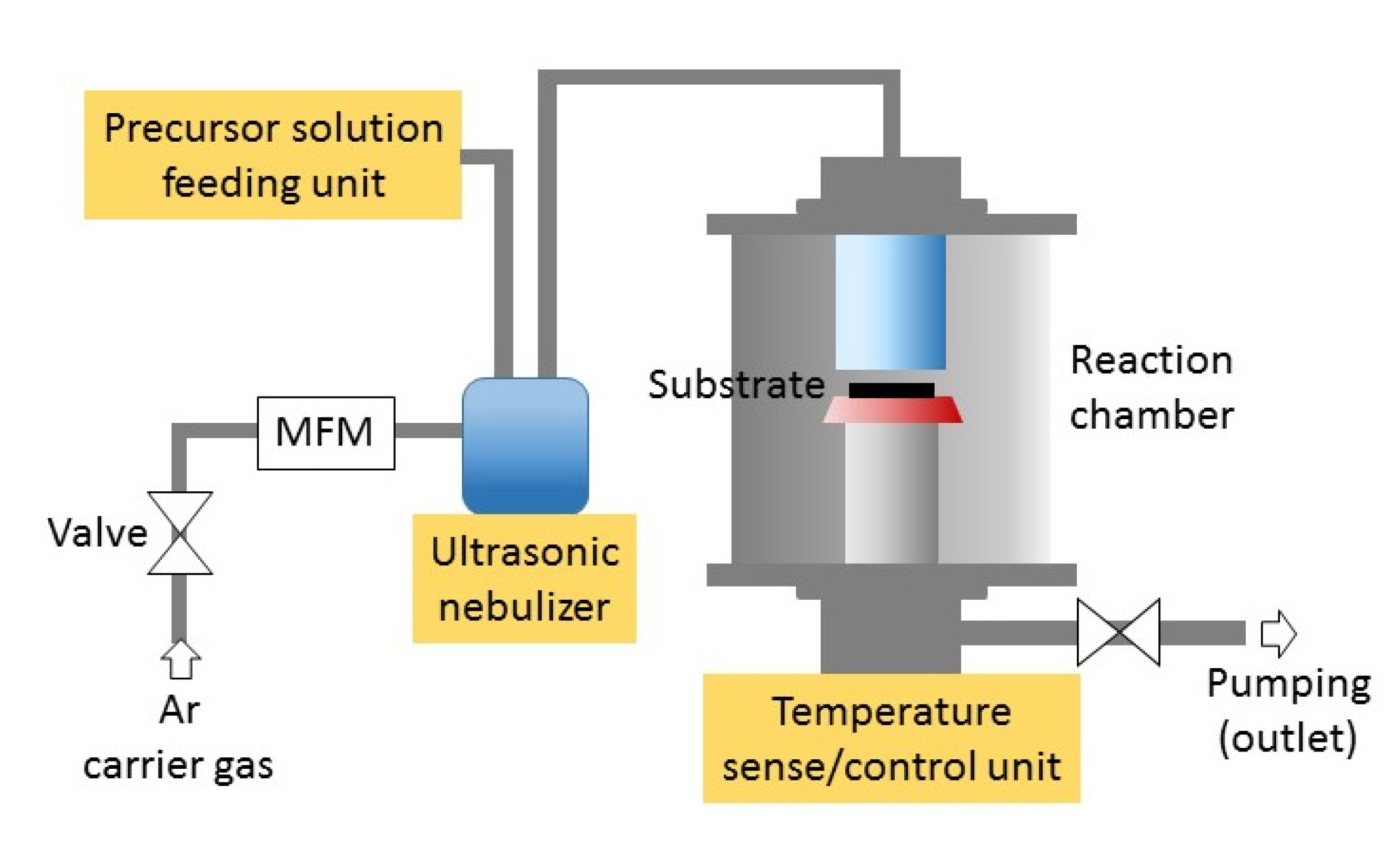
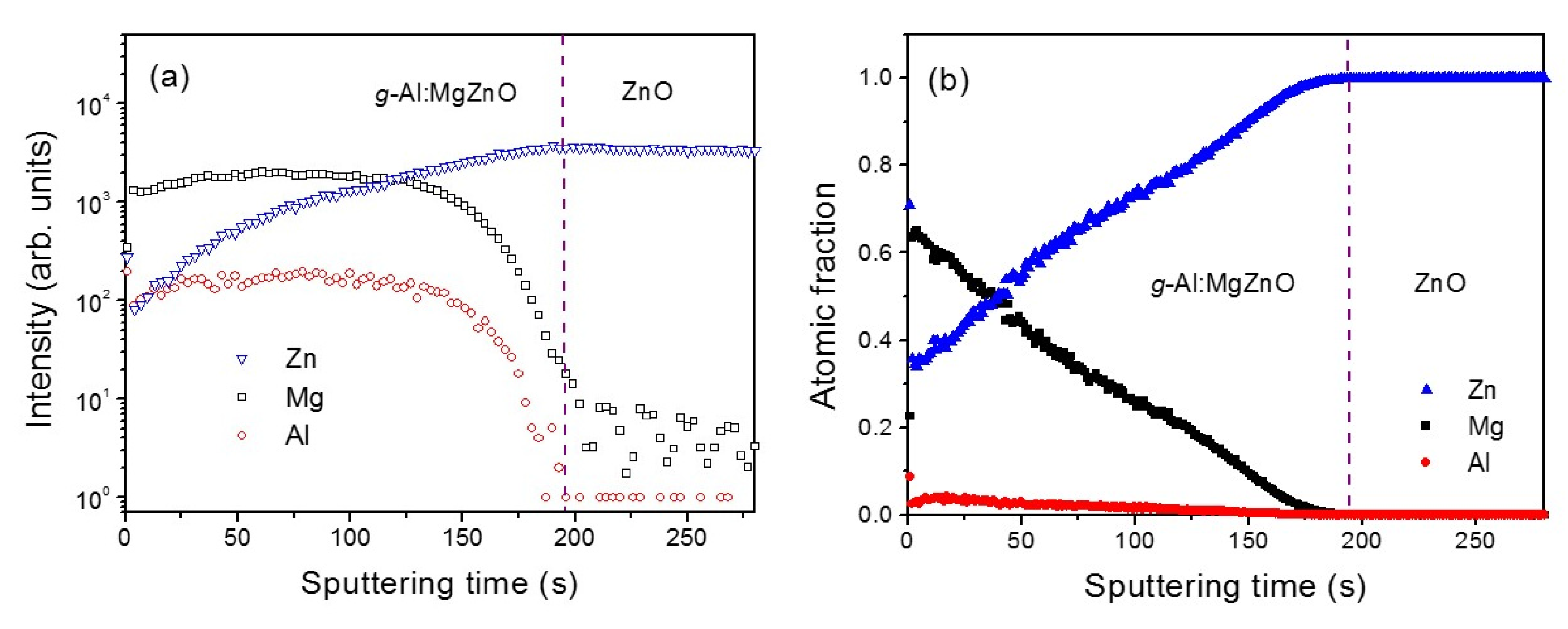
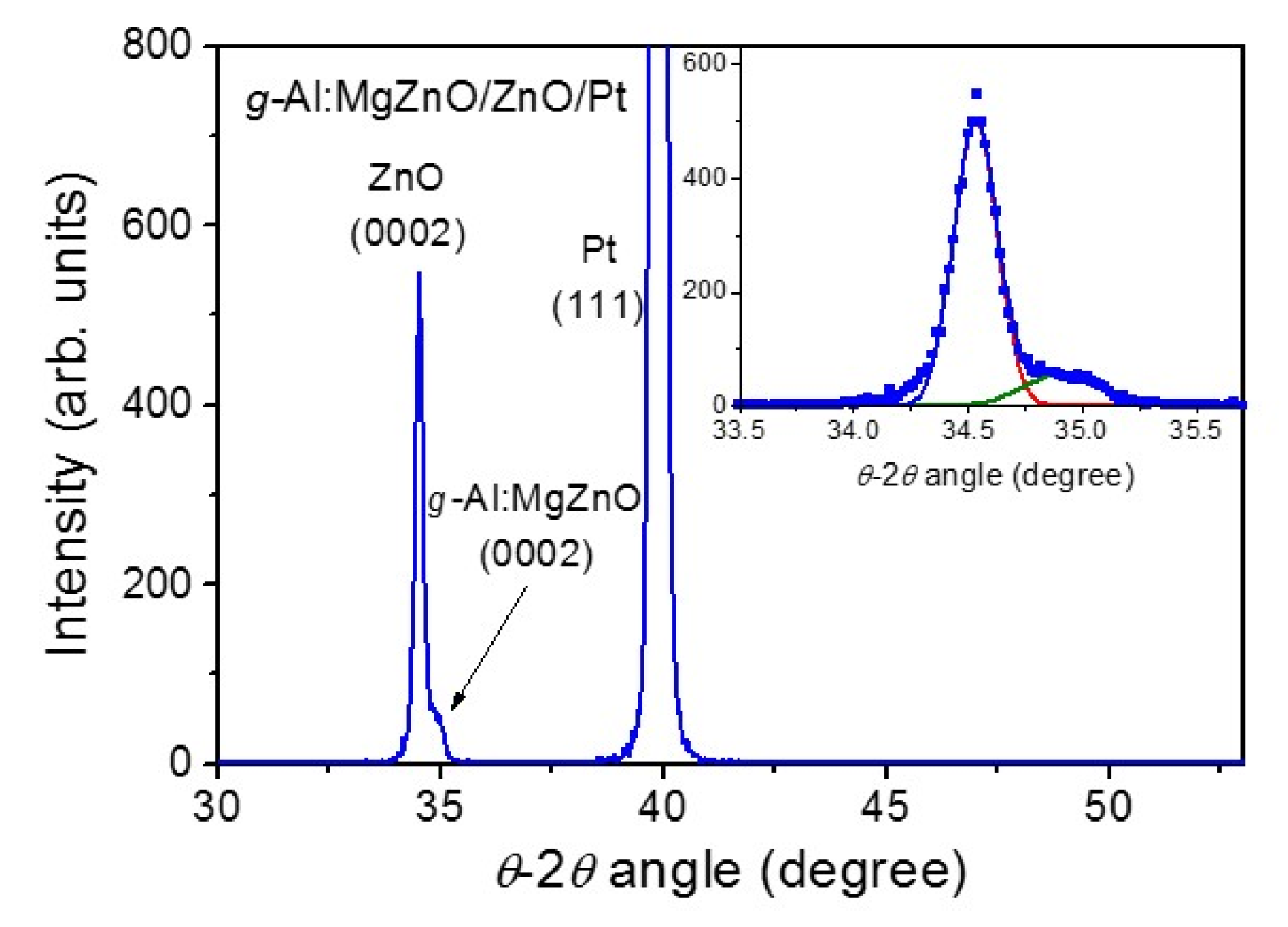


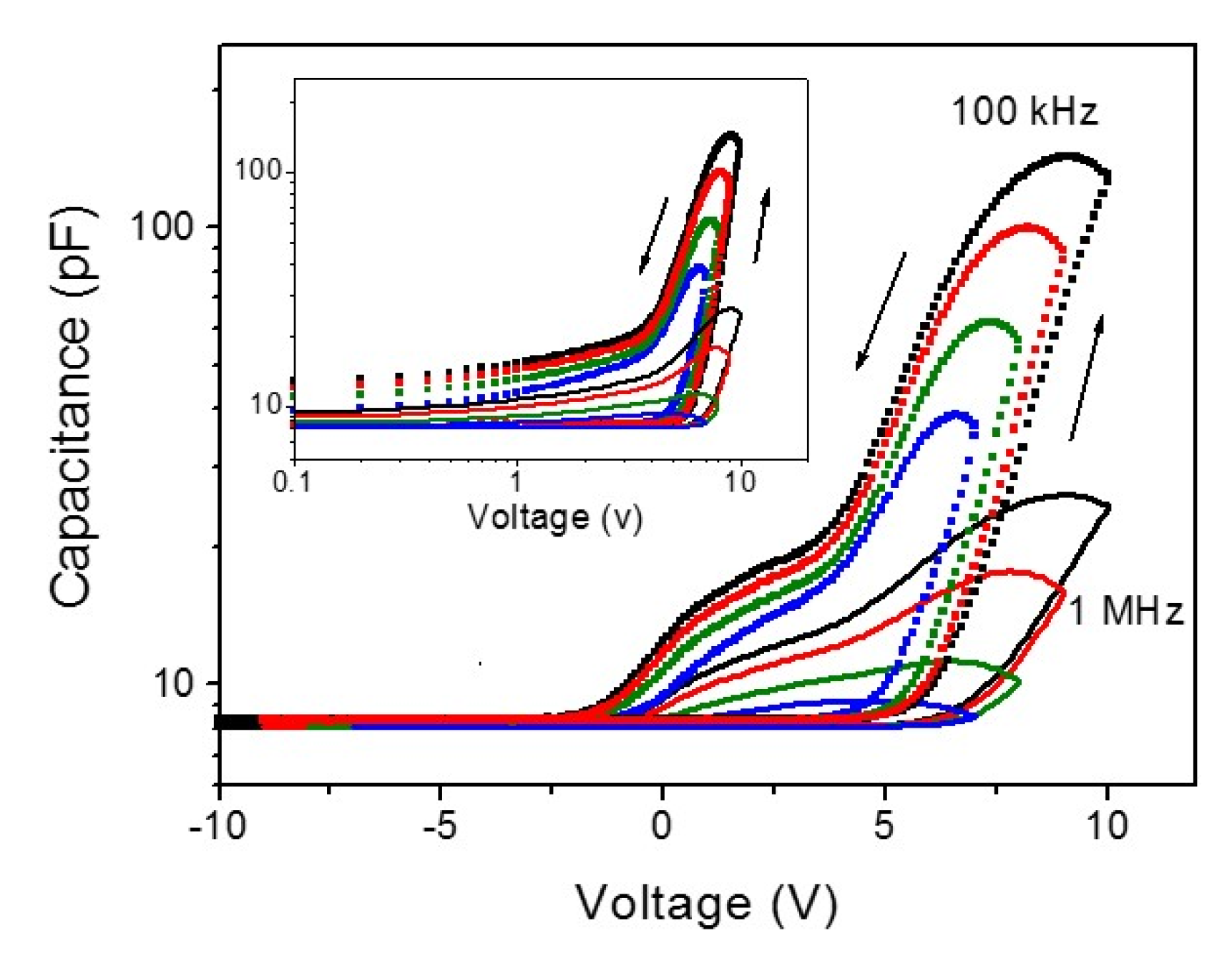

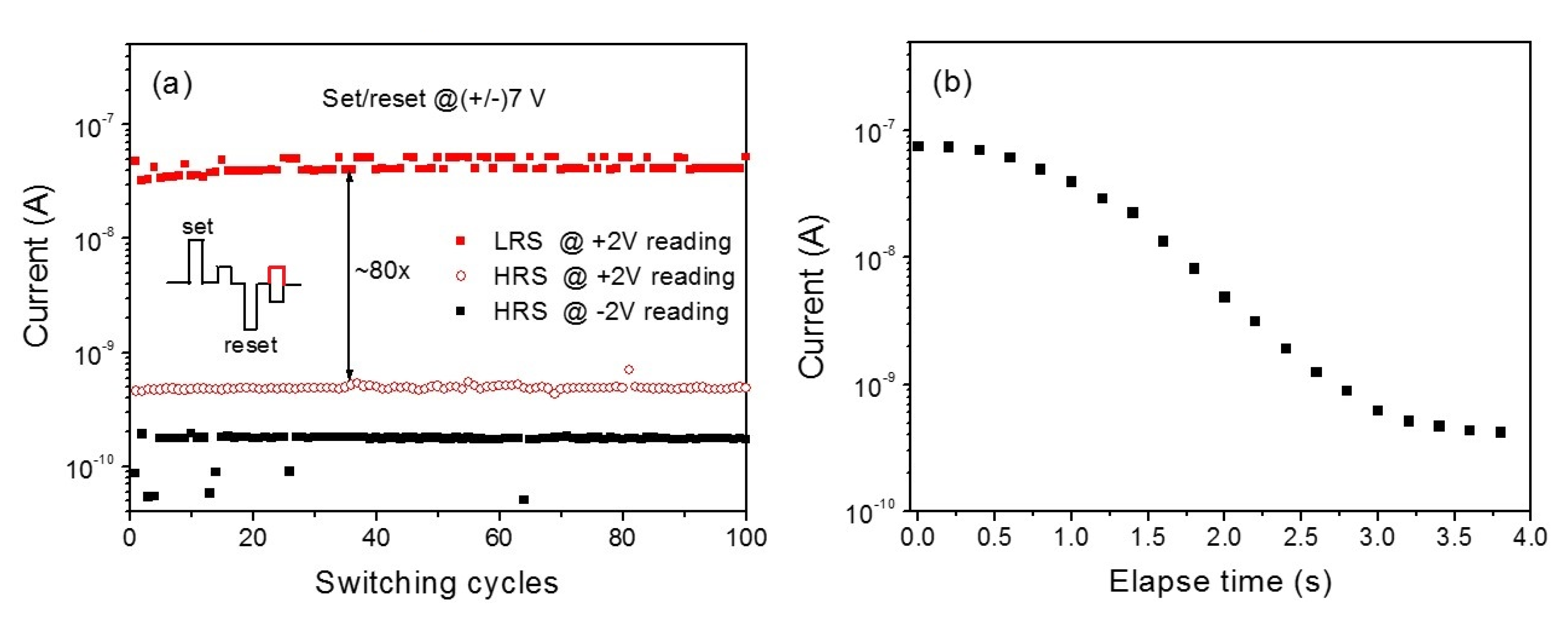
© 2020 by the author. Licensee MDPI, Basel, Switzerland. This article is an open access article distributed under the terms and conditions of the Creative Commons Attribution (CC BY) license (http://creativecommons.org/licenses/by/4.0/).
Share and Cite
Yoon, J.-G. A New Approach to the Fabrication of Memristive Neuromorphic Devices: Compositionally Graded Films. Materials 2020, 13, 3680. https://doi.org/10.3390/ma13173680
Yoon J-G. A New Approach to the Fabrication of Memristive Neuromorphic Devices: Compositionally Graded Films. Materials. 2020; 13(17):3680. https://doi.org/10.3390/ma13173680
Chicago/Turabian StyleYoon, Jong-Gul. 2020. "A New Approach to the Fabrication of Memristive Neuromorphic Devices: Compositionally Graded Films" Materials 13, no. 17: 3680. https://doi.org/10.3390/ma13173680
APA StyleYoon, J.-G. (2020). A New Approach to the Fabrication of Memristive Neuromorphic Devices: Compositionally Graded Films. Materials, 13(17), 3680. https://doi.org/10.3390/ma13173680




